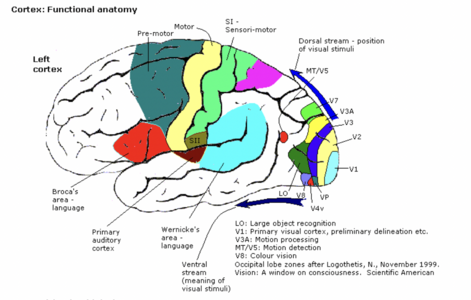Premotor Cortex
Original Editor - Lucinda hampton
Top Contributors - Lucinda hampton, Candace Goh and Tolulope Adeniji
Introduction[edit | edit source]
The premotor cortex is a crucial part of the brain, primarily responsible for preparing and executing movements of the limbs through coordination with other brain areas.[1] It is approximately six times larger than the primary motor cortex and lies anterior to it[2].
Neuronal activity in the prefrontal and premotor areas precedes the activation of the primary motor cortex and spinal cord neurones.[3] During movement planning, certain parts of the cerebellum (ascending pathways) become active before the primary motor cortex, while other parts (descending pathways) involved in motor execution become active after the motor cortex. Simple movements, such as finger flexion, can be carried out via primary motor and sensory areas of the contralateral hemisphere alone. However, more complex movements, like a sequence of finger movements, require additional activation of neurones in the inferior prefrontal cortex and the supplementary cortex, not only in the contralateral cortex but also in the ipsilateral cortex. Premotor neurones are known as 'mirror neurones' because they are active when an individual performs an action and also when they observe someone else performing the same action (see Action Observation Therapy).
Function[edit | edit source]
The premotor cortex appears to play a role in orienting the body and readying the postural muscles for forthcoming movements. This appears to be the case as the premotor cortex mainly projects to the proximal musculature, with efferent fibres from the premotor cortex serving motor neurones of the trunk and shoulders (predominantly) and it receives inputs important for spatial orientation (from the posterior parietal cortex)[4]. It is especially active when motor routines are run in response to visual or somatic sensory cues, such as reaching for an object in full view or identifying an object out of sight by manipulation.
The ventral and lateral areas anticipate and direct the movements of the body in response to external stimuli (eg visual and audio inputs) whilst the medial area responds to internal stimuli from other parts of the brain (eg memories) and acts as a relay station to execute a particular physical act. It is also important in learning, through the practice of imitation, and skills of social cognition through empathy.[1]
Neural Loss in Premotor Cortex May Explain Loss of Motor Function in Older Adults[edit | edit source]
Decline in general body physiological system is a challenge that accompanies ageing. One of these challenges is the deterioration of motor functions, and current research points to a change in white matter integrity, which affects cortico-cortical connectivity. A recent study found that a decrease in dorsal premotor cortex connection to the ipsilateral primary motor cortex (M1) may explain a portion of the motor function impairment reported in older persons.[5]
Physiotherapy Implications[edit | edit source]
Damage to premotor cortex may result in
- Apraxia, an acquired inability to carry out skilled actions that could previously be performed (but without paralysis).
- Deficits in contralateral fine motor control, such as the performance of complex serial movements e.g. In monkeys, lesions of premotor cortex often result in an inability to redirect the paw around the back of a transparent object to reach a food reward. Even with visual feedback indicating that the object is in the way, monkeys with premotor cortex lesions do not recognise the possibility of guiding the paw through an alternative, indirect route.[4]
- Difficulty in using sensory feedback for the control and performance of movements.[6]
References[edit | edit source]
- ↑ 1.0 1.1 Bodytomy Premotor cortex Available:https://bodytomy.com/premotor-cortex-location-structure-function (accessed 29.4.2022)
- ↑ Mtui E, Gruener G, Dockery P. Fitzgerald's Clinical Neuroanatomy and Neuroscience E-Book. Elsevier Health Sciences; 2020 Aug 4. Available: https://www.sciencedirect.com/topics/neuroscience/premotor-cortex(accessed 28.4.2022)
- ↑ Daroff RB, Aminoff MJ. Encyclopedia of the neurological sciences. Academic press; 2014 Apr 29.
- ↑ 4.0 4.1 Rosenbaum DA. Human motor control. Academic press; 2009 Sep 11.Available:https://www.sciencedirect.com/science/article/pii/B978008057108950007X (accessed 29.4.2022)
- ↑ Ni Z, Isayama R, Castillo G, Gunraj C, Saha U, Chen R. Reduced dorsal premotor cortex and primary motor cortex connectivity in older adults. Neurobiology of aging. 2015 Jan 1;36(1):301-3.
- ↑ Brown ed Available: Frontalhttps://www.brown.edu/Courses/BI_278/Other/Teaching%20examples/biomed-370/syllabus/5-frontal.pdf (accessed 28.4.2022)








